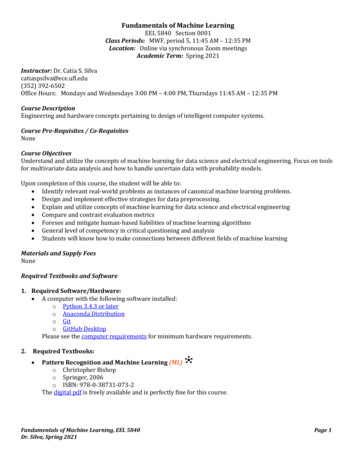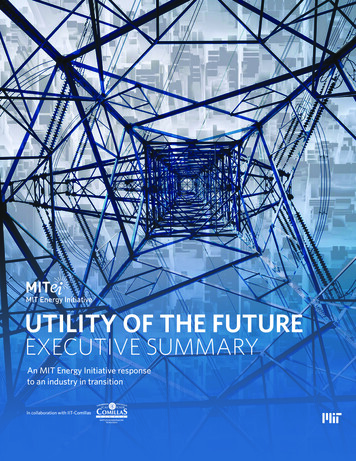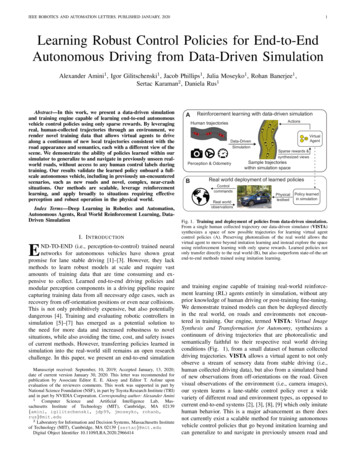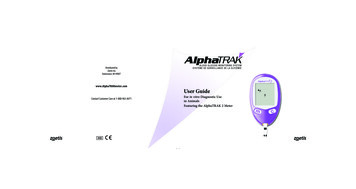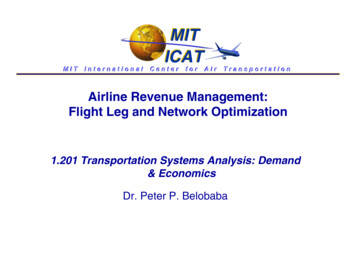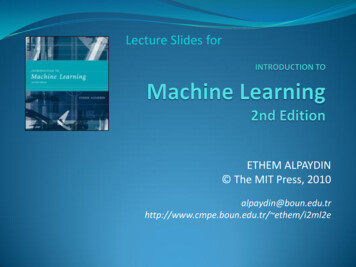
Transcription
Lecture Slides forETHEM ALPAYDIN The MIT Press, r/ ethem/i2ml2e
Why “Learn” ? Machine learning is programming computers to optimizea performance criterion using example data or pastexperience. There is no need to “learn” to calculate payroll Learning is used when: Human expertise does not exist (navigating on Mars), Humans are unable to explain their expertise (speechrecognition) Solution changes in time (routing on a computer network) Solution needs to be adapted to particular cases (userbiometrics)Lecture Notes for E Alpaydın 2010 Introduction to Machine Learning 2e The MIT Press (V1.0)3
What We Talk About When WeTalk About“Learning” Learning general models from a data of particularexamples Data is cheap and abundant (data warehouses, datamarts); knowledge is expensive and scarce. Example in retail: Customer transactions to consumerbehavior:People who bought “Blink” also bought “Outliers”(www.amazon.com) Build a model that is a good and useful approximation tothe data.Lecture Notes for E Alpaydın 2010 Introduction to Machine Learning 2e The MIT Press (V1.0)4
Data Mining Retail: Market basket analysis, Customer relationship management (CRM)Finance: Credit scoring, fraud detectionManufacturing: Control, robotics, troubleshootingMedicine: Medical diagnosisTelecommunications: Spam filters, intrusion detectionBioinformatics: Motifs, alignmentWeb mining: Search engines.Lecture Notes for E Alpaydın 2010 Introduction to Machine Learning 2e The MIT Press (V1.0)5
What is Machine Learning? Optimize a performance criterion using example data orpast experience. Role of Statistics: Inference from a sample Role of Computer science: Efficient algorithms to Solve the optimization problem Representing and evaluating the model for inferenceLecture Notes for E Alpaydın 2010 Introduction to Machine Learning 2e The MIT Press (V1.0)6
Applications Association Supervised Learning Classification Regression Unsupervised Learning Reinforcement LearningLecture Notes for E Alpaydın 2010 Introduction to Machine Learning 2e The MIT Press (V1.0)7
Learning Associations Basket analysis:P (Y X ) probability that somebody who buys X also buysY where X and Y are products/services.Example: P ( chips beer ) 0.7Lecture Notes for E Alpaydın 2010 Introduction to Machine Learning 2e The MIT Press (V1.0)8
Classification Example: Creditscoring Differentiatingbetween low-riskand high-riskcustomers from theirincome and savingsDiscriminant: IF income θ1 AND savings θ2THEN low-risk ELSE high-riskLecture Notes for E Alpaydın 2010 Introduction to Machine Learning 2e The MIT Press (V1.0)9
Classification: Applications Aka Pattern recognition Face recognition: Pose, lighting, occlusion (glasses, beard), make-up, hair styleCharacter recognition: Different handwriting styles.Speech recognition: Temporal dependency.Medical diagnosis: From symptoms to illnessesBiometrics: Recognition/authentication using physicaland/or behavioral characteristics: Face, iris, signature, etc.Lecture Notes for E Alpaydın 2010 Introduction to Machine Learning 2e The MIT Press (V1.0)10
Face RecognitionTraining examples of a personTest imagesORL dataset,AT&T Laboratories, Cambridge UKLecture Notes for E Alpaydın 2010 Introduction to Machine Learning 2e The MIT Press (V1.0)11
Regression Example: Price of a usedcar x : car attributesy : pricey g (x q )g ( ) model,q parametersLecture Notes for E Alpaydın 2010 Introduction to Machine Learning 2e The MIT Press (V1.0)y wx w012
Regression Applications Navigating a car: Angle of the steering Kinematics of a robot arm(x,y)α2α1 g1(x,y)α2 g2(x,y)α1 Response surface designLecture Notes for E Alpaydın 2010 Introduction to Machine Learning 2e The MIT Press (V1.0)13
Supervised Learning: Uses Prediction of future cases: Use the rule to predict theoutput for future inputs Knowledge extraction: The rule is easy to understand Compression: The rule is simpler than the data it explains Outlier detection: Exceptions that are not covered by therule, e.g., fraudLecture Notes for E Alpaydın 2010 Introduction to Machine Learning 2e The MIT Press (V1.0)14
Unsupervised Learning Learning “what normally happens” No output Clustering: Grouping similar instances Example applications Customer segmentation in CRM Image compression: Color quantization Bioinformatics: Learning motifsLecture Notes for E Alpaydın 2010 Introduction to Machine Learning 2e The MIT Press (V1.0)15
Reinforcement Learning Learning a policy: A sequence of outputs No supervised output but delayed reward Credit assignment problem Game playing Robot in a maze Multiple agents, partial observability, .Lecture Notes for E Alpaydın 2010 Introduction to Machine Learning 2e The MIT Press (V1.0)16
Resources: Datasets UCI Repository: http://www.ics.uci.edu/ mlearn/MLRepository.html UCI KDD ation.html Statlib: http://lib.stat.cmu.edu/ Delve: http://www.cs.utoronto.ca/ delve/Lecture Notes for E Alpaydın 2010 Introduction to Machine Learning 2e The MIT Press (V1.0)17
Resources: Journals Journal of Machine Learning Research www.jmlr.orgMachine LearningNeural ComputationNeural NetworksIEEE Transactions on Neural NetworksIEEE Transactions on Pattern Analysis and MachineIntelligence Annals of Statistics Journal of the American Statistical Association .Lecture Notes for E Alpaydın 2010 Introduction to Machine Learning 2e The MIT Press (V1.0)18
Resources: Conferences International Conference on Machine Learning (ICML)European Conference on Machine Learning (ECML)Neural Information Processing Systems (NIPS)Uncertainty in Artificial Intelligence (UAI)Computational Learning Theory (COLT)International Conference on Artificial Neural Networks(ICANN) International Conference on AI & Statistics (AISTATS) International Conference on Pattern Recognition (ICPR) .Lecture Notes for E Alpaydın 2010 Introduction to Machine Learning 2e The MIT Press (V1.0)19
Machine learning is programming computers to optimize a performance criterion using example data or past experience. There is no need to “learn” to calculate payroll Learning is used when: Human expertise does not exist (navigating on Mars), Humans are unable to explain their expertise (speech recognition)
